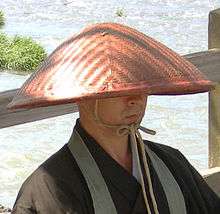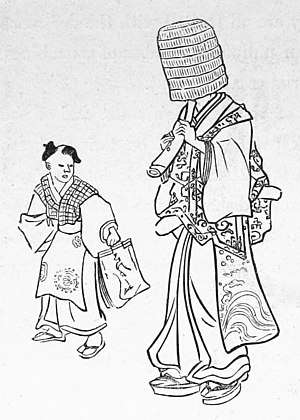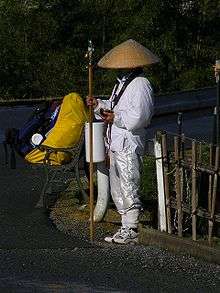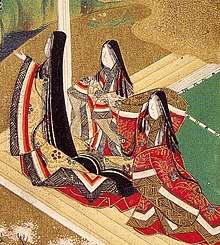Kasa (hat)
A kasa (笠) is a term used for any one of several traditional Japanese hats.[1] These include amigasa and jingasa.
Grammar
Kasa is the correct way to pronounce the word when it stands alone. Note that rendaku causes kasa to change to gasa when it is preceded by another word specifying the type of hat: thus, jingasa.
Kasa shares its etymology with the Japanese word for "umbrella" (which is also pronounced "kasa", but written 傘).
Styles
There are several different styles of kasa.
Almost all hats were painted. Mostly, this color was black. It was used for low ranking samurai.
Jingasa almost always had mon marks on them.
An amigasa is a straw hat of the type traditionally worn in some Japanese folk dances. Another kind of kasa, the woven rice-straw takuhatsugasa worn by mendicant Buddhist monks, is made overlarge and in a bowl or mushroom shape. Unlike an Asian conical hat, it does not come to a point, nor does it ride high on the head like a samurai's traveling hat. It is simply a big hat that covers the upper half to two thirds of the face, thereby helping to mask the identity of the monk and allowing him to travel undistracted by sights around him on his journey.
The samurai class in feudal Japan, as well as their retainers and ashigaru "footsoldiers", used several types of jingasa made from iron, copper, wood, paper, bamboo, or leather.[2][3]
Types
Some types of kasa include:
- Ajirogasa (a wickerwork kasa made of shaven bamboo or wood)
- Amigasa (a wickerwork kasa)
- Fukaamigasa (a deep wickerwork kasa)
- Jingasa ("war hat", a type of kasa commonly worn by samurai and ashigaru)
- Roningasa (typically a conical amigasa with a flat top, often worn by ronin)
- Sandogasa (a kasa for traveling)
- Sugegasa (see Asian conical hat)
- Takuhatsugasa (a Buddhist mendicant kasa)
- Tengai (see Komusō Monk)
- Torioigasa (a folded kasa, famous for Awa Dance Festival)
- Yagyūgasa (the family crest of Yagyū clan, not a kind of actual kasa)
Gallery
 A Buddhist monk wearing a takuhatsugasa (also an ajirogasa).
A Buddhist monk wearing a takuhatsugasa (also an ajirogasa). The hat in this print is a fukaamigasa of the sort known as tengai (天蓋), worn by komusō, mendicant monks of Fuke Zen.
The hat in this print is a fukaamigasa of the sort known as tengai (天蓋), worn by komusō, mendicant monks of Fuke Zen. These women at the Awa Dance Festival wear the characteristic kasa of the dance.
These women at the Awa Dance Festival wear the characteristic kasa of the dance.- Various jingasa from the Return of the Samurai, an exhibit of Samurai art and artifacts held in the Art Gallery of Greater Victoria, Victoria B.C. Canada, August 6 through November 14, 2010.
 A Buddhist pilgrim begging for alms outside a Buddhist temple.
A Buddhist pilgrim begging for alms outside a Buddhist temple.
See also
- Yatarō gasa ("Yataro’s Travel Hat"), a 1957 film by Kazuo Mori
- Salakot
- Asian conical hat
References
- Kasa hat Retrieved 03-19-2016
- Tanaka, Fumon (2003). Samurai Fighting Arts: The Spirit and the Practice. Kodansha International. p. 46. ISBN 978-4-7700-2898-3.
- Ratti, Oscar; Westbrook, Adele (1991). Secrets of the Samurai; A Survey of the Martial Arts of Feudal Japan. C. E. Tuttle. p. 219. ISBN 978-0-8048-1684-7.
External links
| Wikimedia Commons has media related to Kasa (hat). |
- Haiku Topics (01) ..... (WKD - TOPICS): Hat (kasa) at Haiku Topics (in English)
